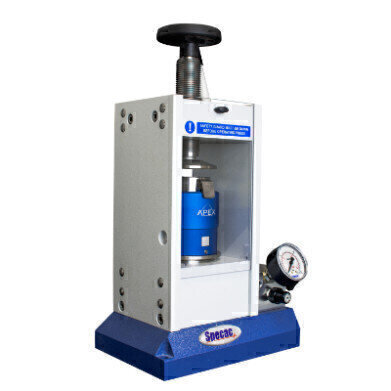Mass Spectrometry & Spectroscopy
Award Winning Manual Press
Mar 03 2020
Specac’s Manual Hydraulic Presses are available in 15 and 25 ton load configurations for a wide variety of laboratory pressing applications. It is well suited to the manufacture of KBr pellets for FTIR spectroscopy as well as sample pellets and targets for other spectroscopic techniques such as XRF. It is also suitable for analysis of polymers and thin films when used with the heated Platens and Constant Thickness Film Makers manufactured by Specac.
Specac know that their press has been used in diverse applications such as cocoa powder analysis and brake pads, see below:
A Doctor at the the University of Ghana, has been analysing unsweetened natural cocoa powder (UNCP) for its potential in amplifying the anti-malarial High Dose Artemether/Lumefantrine-Induced drug on the liver. Cocoa powder contains antioxidant polyphenols called avonols, which are reported to have liver-protective properties. Using Energy-Dispersive X-Ray Fluorescence (EDXRF), unsweetened natural cocoa powder was analysed before being supplied orally to thirty male guinea pigs under various dosages of the drugs. The findings suggested that the cocoa powder increased nitric oxide levels, however, a higher level of copper was observed, suggesting a detrimental effect of high daily UNCP consumption.
Detecting carcegonics in brake pads by research at Lund University. A 15 ton manual press was used to investigate whether asbestos was found in dust particles from car vehicle brake pads. Brake pads were removed from a selection of vehicles and ground with a 100g hammer (coated with 20 layers of paper to avoid direct contact). An agate mill was then used to homogenise the samples and the filtered pieces were washed and then sieved from water.
The particulate form of this substance has been described as posing a significant cancer risk if consumed, when released through friction (i.e. applying brakes). EDXRF analysis was used to determine the composition of all samples. Findings showed that a significant amount of the dust was determined as inhalable and they also found other toxic metals in the pads and dust, however no asbestos fibres were found in dust which was a relief in this experiment.
More information online
Digital Edition
Lab Asia 31.2 April 2024
April 2024
In This Edition Chromatography Articles - Approaches to troubleshooting an SPE method for the analysis of oligonucleotides (pt i) - High-precision liquid flow processes demand full fluidic c...
View all digital editions
Events
Apr 28 2024 Montreal, Quebec, Canada
May 05 2024 Seville, Spain
InformEx Zone at CPhl North America
May 07 2024 Pennsylvania, PA, USA
May 14 2024 Oklahoma City, OK, USA
May 15 2024 Birmingham, UK


















